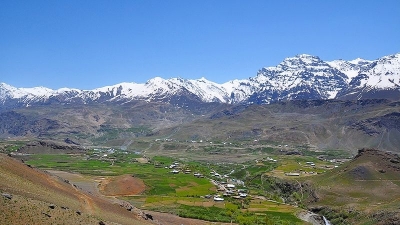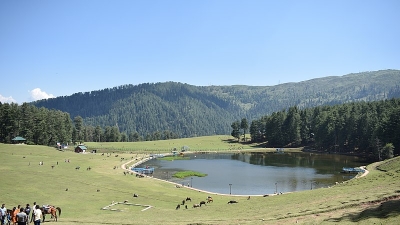Kargil Attractions - Tourist Places To Visit In Kargil
-
01Mulbekh Monastery
+ Read MoreMulbekh Monastery is situated in the village of Mulbekh, about 45 km from Kargil located at the end of a valley. The monastery stands at an elevation of around 200 m above the road, positioned on the top of a hill. The gompa or the monastery contains a 9 m long statue of the Maitreya Buddha, also known as the Buddha of the future or Laughing Buddha.
It is said that the idol was carved during the 8th century and was brought here by the missionaries who introduced Buddhism in Ladakh. The monastery also has the remains of several Buddhist monks. The artwork of the idol and the architecture of the monastery prove that these monasteries do not belong to Tibet.
-
02Rangdum Monastery
+ Read MoreRangdum Monastery or gompa is located at an elevation of 3657 m above sea level in the village of Rangdum. It is said to have been built during the 8th century and is considered as one of the major landmarks in the district. A museum in the monastery holds a collection of Tibetan artefacts along with some regional art works. More than 40 monks live in this monastery.
-
03Dzongkhul Monastery
 + Read More
+ Read MoreDzongkhul Monastery lies on the trekking route of Padum-Kishtwar and is constructed within a spectacular cave. Situated on the Ating Gorge, this monastery is associated with a popular Indian yoga guru known as Naropa. The monastery is built around two caves where Naropa meditated during his existence. The walls of the caves are covered with very old paintings which reflect the artistic style of that time.
-
04Phokar
 + Read More
+ Read MorePhokar, also known as Fokar, is situated in the vicinity of the Shargole Monastery on top of a hill. The place is known for the Phokar Rizong and the Urgyen Dzong. The Phokar Rizong is positioned on a circular flat ground and serves as an ideal place for meditation. It is surrounded by caves and peaks and has several other religious centres founded by Buddhist saints including Padmasambhava, a popular Buddhist guru in the area.
Tourists can reach the place by trekking to the hilltop. Two routes take visitors to the place. One is a cave route that is 1 km long and the other around the mountain, which is around 4 km long. The cave route remains closed through June and July.
-
05Padum
 + Read More
+ Read MorePadum also known as Padam is located at a distance of about 240 km from Kargil and is the largest town of the Zanskar tehsil. In older times, this town acted as the capital of the Zanskar Empire. The prime attractions of the town include the Mud Palace of the local king, a small monastery and rock carvings from the 8th century found near a river. An ancient village known as Pibiting, located on a small hill there, has a beautiful monastery which also attracts visitors.
-
06Zangla
 + Read More
+ Read MoreZangla is a town in the Zanskar tehsil situated at a distance of around 35 km from the town of Padum. During winters, the river Zanskar which flows from Padum to Zangla freezes over completely. The ice formed is so dense that it can bear the weight of people walking on it. The sheet of ice is known by locals as chadar. Small caves located near the ice-covered river serve as a place for travellers to camp during the night. Zangla serves as a base camp for summer trekkers there.
-
07Zanskar - The Virgin Valley
+ Read MoreZanskar is a tehsil situated on the northern side of Jammu & Kashmir in the Kargil district. For about eight months of the year, annually, the place receives heavy snowfall which leaves the place completely isolated and cut off from the rest of the world.
Two small lakes situated at altitudes ranging between 4,401 m and 4,450 m are present in the area. The place has numerous monasteries showcasing the Tibet styles of architecture, such as the Dzongkhul, Stongdey and Karsha. Numerous camping sites, located at the uppermost point also attract tourists in large numbers.
The Drang-Drung Glacier, which is quite a popular attraction, can be spotted on the way to Zanskar. Positioned amidst the Suru Valley, the place offers a panoramic view of the mighty Himalayas along with Kargil. Some of the other prime tourist attractions of this place are Karsha Monastery, Phugtal Monastery and Starrimo Monastery.
-
08Phugtal Monastery
 + Read More
+ Read MorePhugtal, known for its spectacular location, is built outside a huge cave from where a major stream of the river Lungnak flows. This Buddhist monastic establishment is one of the most isolated monasteries found in the Zanskar region. Founded in the early 12th century, this monastery has beautiful murals and ceiling embellishments that showcase the Indian style of art.
-
10Sani Monastery
 + Read More
+ Read MoreSani Monastery, also known as Turtot Gyat, located in the vicinity of the village of Sani, is one of the most popular religious centres for Buddhists in the world. This gompa or monastery is one of the 8 sacred monasteries in the world. It is said that in older times, Buddhist luminaries, such as Naropa, Padmasambhava and Marpa, visited this monastery. Built in the 1st century by the well-known Kushan King Kanishka, this monastery belongs to the Drukpa Kagyu School of Tibetan Buddhism. This gompa is also counted amongst the oldest gompas in the regions of Ladakh and Zanskar.
The monastery is home to one of the 108 chortens or stupas, a domed structure serving as a Buddhist shrine, constructed during the 1st century by King Kanishka. The chorten, popular as the Kanika Chorten, measures 20 ft in height and is placed in the backyard of the monastery. The compound of the monastery is rectangular in shape. The dukhand or the assembly hall contains pictures of Chamba, Chenren and Padmasambhava. A small room with a bookshelf having sacred volumes of the Kangyur, the Tibetan Buddhist canon consisting of a list of sacred texts that the various schools of Tibetan Buddhism recognise, is placed inside the monastery. The monastery also has a small Naropa shrine.
Every year in the months of July and August, a mask dance is organised at the monastery. Other popular festivals include the Sani Naro-Nasjal and Great Prayer.
-
11Kursha Monastery
+ Read MoreKursha Monastery, situated around 10 km from Padum, is the largest monastic set-up of Zanskar. The monastery has numerous chapels along with rooms for more than 150 Buddhist monks. It is also the wealthiest and the biggest monastery in the entire region. Placed in the lap of nature, this gompa was established in the 11th century by Phagspa Sherab. The complex of the monastery has two assembly halls, eight temples and a library. This library is known to be the largest library in the region of Zanskar.
Ancient murals can be seen on the walls of the Thabrang or room of God and religion. The history of these frescoes date back to the 15th century. The other end of the monastery houses a Chomo Gompa or nunnery known as the Dorje Dzong.
-
12Stongdey Monastery
 + Read More
+ Read MoreStongdey Monastery, located 20 km from Padum in the north, has been constructed on a rocky projection. Presently, this gompa stands as the second largest monastic establishment in Zanskar with around 60 Gelug or Yellow Hat sect monks. The Gon Khang or the Temple of Guardian Deities is the major attraction of this monastery.



 Click it and Unblock the Notifications
Click it and Unblock the Notifications










